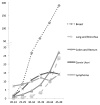Colorectal cancer is a leading cause of cancer incidence and mortality among adults younger than 50 years in the USA: a SEER-based analysis with comparison to other young-onset cancers
- PMID: 27864324
- PMCID: PMC5564445
- DOI: 10.1136/jim-2016-000229
Colorectal cancer is a leading cause of cancer incidence and mortality among adults younger than 50 years in the USA: a SEER-based analysis with comparison to other young-onset cancers
Abstract
Colorectal cancer (CRC) incidence and mortality are rising among young adults. Our aim was to contrast the relative incidence and mortality of CRC to other common cancers among young adults in the USA. We used Surveillance, Epidemiology, and End Results registry data to compare cancer site-specific and age-specific mortality and incident rates for adults younger than age 50. We summarized extracted data, both overall, and stratified by sex. We found CRC was the third leading cause of cancer death among adults younger than age 50, after breast and lung cancer (1.67 cases per 100,000). Among young women, CRC was the fourth leading cause of cancer death (1.51 per 100,000). Among young men, CRC was the second leading cause of cancer death (1.82 cases per 100,000). CRC was the second most incident cancer among young adults for men and women combined. Among men, CRC was the second most incident cancer after age 30, with 4.9, 9.0, 16.4, and 30.8 cases per 100,000 for ages 30-34, 35-39, 40-44, and 45-49 years, respectively. Among women, CRC incidence was similar with 4.2, 7.6, 15.3, and 25.9 cases per 100,000 for ages 30-34, 35-39, 40-44, and 45-49 years, respectively. These results show that CRC is a leading cause of cancer incidence and mortality among young adults in the USA, relative to other cancers. Given trends toward increasing rates of CRC among young adults, strategies for identifying individuals at risk for young-onset CRC who might benefit from early age of screening initiation merit investigation.
Keywords: Cancer; Colon; Colonic Neoplasms; Colorectal Neoplasms.
Copyright © 2016 American Federation for Medical Research.
Conflict of interest statement
Figures






Similar articles
-
The increasing incidence of young-onset colorectal cancer: a call to action.Mayo Clin Proc. 2014 Feb;89(2):216-24. doi: 10.1016/j.mayocp.2013.09.006. Epub 2014 Jan 4. Mayo Clin Proc. 2014. PMID: 24393412
-
Increasing disparities in the age-related incidences of colon and rectal cancers in the United States, 1975-2010.JAMA Surg. 2015 Jan;150(1):17-22. doi: 10.1001/jamasurg.2014.1756. JAMA Surg. 2015. PMID: 25372703 Free PMC article.
-
Colorectal cancer statistics, 2017.CA Cancer J Clin. 2017 May 6;67(3):177-193. doi: 10.3322/caac.21395. Epub 2017 Mar 1. CA Cancer J Clin. 2017. PMID: 28248415
-
The Rising Incidence of Younger Patients With Colorectal Cancer: Questions About Screening, Biology, and Treatment.Curr Treat Options Oncol. 2017 Apr;18(4):23. doi: 10.1007/s11864-017-0463-3. Curr Treat Options Oncol. 2017. PMID: 28391421 Review.
-
Early-onset colorectal cancer in young individuals.Mol Oncol. 2019 Feb;13(2):109-131. doi: 10.1002/1878-0261.12417. Epub 2018 Dec 22. Mol Oncol. 2019. PMID: 30520562 Free PMC article. Review.
Cited by
-
Different disease characteristics in young patients with colorectal cancer: a large retrospective study in a city in Romania.J Int Med Res. 2021 May;49(5):3000605211016630. doi: 10.1177/03000605211016630. J Int Med Res. 2021. PMID: 34034541 Free PMC article.
-
HIF-2α activation potentiates oxidative cell death in colorectal cancers by increasing cellular iron.J Clin Invest. 2021 Jun 15;131(12):e143691. doi: 10.1172/JCI143691. J Clin Invest. 2021. PMID: 33914705 Free PMC article.
-
Emerging roles of TRIM27 in cancer and other human diseases.Front Cell Dev Biol. 2022 Sep 19;10:1004429. doi: 10.3389/fcell.2022.1004429. eCollection 2022. Front Cell Dev Biol. 2022. PMID: 36200036 Free PMC article. Review.
-
Cannabidiol-from Plant to Human Body: A Promising Bioactive Molecule with Multi-Target Effects in Cancer.Int J Mol Sci. 2019 Nov 25;20(23):5905. doi: 10.3390/ijms20235905. Int J Mol Sci. 2019. PMID: 31775230 Free PMC article. Review.
-
Hibiscus Anthocyanins Extracts Induce Apoptosis by Activating AMP-Activated Protein Kinase in Human Colorectal Cancer Cells.Nutrients. 2023 Sep 14;15(18):3972. doi: 10.3390/nu15183972. Nutrients. 2023. PMID: 37764756 Free PMC article.
References
-
- Torre LA, Bray F, Siegel RL, et al. Global cancer statistics, 2012. CA Cancer J Clin. 2015;65:87–108. - PubMed
-
- Siegel RL, Jemal A, Ward EM. Increase in incidence of colorectal cancer among young men and women in the United States. Cancer Epidemiol Biomarkers Prev. 2009;18:1695–8. - PubMed
-
- You YN, Xing Y, Feig BW, et al. Young-onset colorectal cancer: is it time to pay attention? Arch Intern Med. 2012;172:287–9. - PubMed
-
- Ahnen DJ, Wade SW, Jones WF, et al. The increasing incidence of young-onset colorectal cancer: a call to action. Mayo Clin Proc. 2014;89:216–24. - PubMed
Publication types
MeSH terms
Grants and funding
LinkOut - more resources
Full Text Sources
Other Literature Sources
Medical

